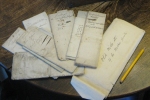I’m aiming to write and post a little bit each day about the family history research I’m doing, and what I find, during a week staying in Edinburgh. But for personal privacy, the posting of these travels on AFamilyHistoryBlog will be delayed by a few days, and will not necessarily be in day by day order! Some of these posts may be given later tweaks, with added photos, etc.
Update; You can now see all the posts from my May 2017 Scotland trip, here;
Day 1 – day 2 – day 3 – day 4 – day 5 – day 6 – day 7 – & day 8 & the big family gathering.

I spent much of a day in the archives at Hopetoun House, South Queensferry, near Edinburgh. I was looking into my WALKER ancestors, who were tenant farmers on the Hopetoun Estate through from the mid 18th to the end of the 19th century, and into the farms where they lived and worked.
Among other things, there are bits in the Walker family history, originally written by my Grandfather in the 1950’s, which I don’t know any original sources for. So I was hoping that I might find some of those in the Hopetoun archive records.

I had previously been in contact by email with the volunteer archivists at Hopetoun, so they knew that I planned to visit. I arrived at Hopetoun House at 10:30am, as it was opening to public visitors. I went in to the lower ground floor reception, to the right of the main staircase up to the front door (where most public visitors go into the house). I was soon met by one of the archivists, Richard, who took me up through service stairs and corridors, to an archive research room on an upper floor.

I spent several hours there, looking through a number of bundles of old documents; lease agreements (tacks), etc, and was permitted to photograph anything I saw that looked to be of interest. Each bundle has a reference number, and is catalogued in the National Register of Archives for Scotland (NRAS). All the papers in the Hopetoun Archives appear to begin with the catalogue reference “NRAS888/”. In the archive room I was able to search this catalogue, on a computer, to identify the catalogue entries that looked to be of most interest.
(Unfortunately on the internet the full catalogue does not appear to be available! When I search the NRAS Register, it only gives the “top level record” for the papers of the Hopetoun Estate; NRAS888. The individual records, which I was able to search for in the archive room at Hopetoun House, do not appear to be available to search for online!)
Among the papers I saw, there were estate copies of two or three of the same documents that I’ve already posted copies of onto AFamilyHistoryBlog from among the WALKER family papers that I have.
My STAR FINDS from among the papers that I saw at Hopetoun House were plans of Hiddlefaulds (which was demolished in the 1890’s) and of the farm buildings at Kilpunt – both plans dated 1841, along with notes which confirmed that the WALKER family became tenants at Hiddlefaulds in (or slightly before) 1745.
A printed document about the rental income from the estates of “Pumpberston, Illieston, and Kilpunt”, (associated with the sale of these estates at the time that Lord Hope acquired them, circa 1760), details that William WALKER was the tenant in Hiddlefaulds in 1745, but a David KER was the tenant in 1740. A handwritten footnote on this page says that “when Will Walker took Hiddlefaulds he was promised a Tack [a lease agreement] but never got it.“! So the original paperwork was never done! ☻
In total, I took over 170 photos of the documents I saw, that looked to be of interest to me in my family history. These came from the following NRAS catologue numbers (with partial descriptions);
- NRAS 888/16/Bundle 4; miscellaneous papers – including “lease of Kilpunt – 1843”
- NRAS 888/28/Bundle 8; “papers relative to lease of Newmains, Overtoun and Kilpunt” – 1834
- NRAS 888/28/Bundle 10; Tacks and Papers as to Kilpunt and Illieston, 1760 – 1830″
- NRAS 888/40/Bundle 3; “papers relating to the lease of Kilpunt – including sketches for farm buildings – 1842”
- NRAS 888/1879; “sketch of lands (of Kilpunt) – 1757”.
Its worth noting that the NRAS catalogue descriptions tend to identify the titled estates (such as Kilpunt), but not individual farms (such as Hiddlefaulds).
Its going to take me some time to process all of this, and I know that if I ever get the time and opportunity to go back to the Hopetoun Archives, there is quite a lot more of interest to look at there.
From what I heard the archivist saying, I gather that they have had very few people, like me, visiting the Hopetoun archives to do family history research into the tenant farmers on the estate. But from what I’ve seen, the Hopetoun archives must be a great resource for anyone who is researching a family history with this kind of connection to the Hopetoun estate.

















